

By
Don and Linda Freedman
Search
TheTravelzine
TheTravelzine Group
Access Your Mail
Don's
Gallery
Packing
Hints
Planning
Tips
Cities
Links
Links
LINKS TO OUR TRAVELOGUES
Argentina, Buenos Aires - Jan-Mar 2010
Argentina, Buenos Aires - Jan-Mar 2009
Argentina, Buenos Aires - Jan-Mar 2008
Austria - Fall 2005
Belgium, Brussels - Fall 2000
Canada - Summer 2002
Canada - Summer 2001
Canada - Summer 2000
Czech Republic - Spring 2000
France - Fall 2002
France, Paris - Fall 2000
France, Paris - Spring 1999
France, Lyon - Spring 1999
Germany, Berlin - Fall 2009
Germany - Fall 2002
Germany - Spring 2000
Germany - Fall 1999
Greece - Fall 2012
Greece - Fall 1999
Greece - Fall 1997
Hungary - Spring 2000
Israel - Fall 1999
Italy - Winter 2007
Italy - Winter 2006
Italy - Winter 2005
Italy - Winter 2004
Italy - Winter 2003
Italy - Winter 2001
Italy - Fall 1998
Italy - Fall 1996
Netherlands - Spring 2000
Portugal, Azores - 2019
Portugal, Azores - 2018
Portugal, Sao Miguel & Lisbon - 2017
Portugal, Azores - 2017
Portugal, Azores - 2016
Portugal, Azores - 2015
Portugal, Azores - 2014
Portugal, Azores - 2013
Portugal, Azores - 2012
Portugal, Azores - 2011
Portugal, Lisbon - 2011
Portugal - Fall 2006
Portugal - Fall 2004
Portugal - Fall 2003
Portugal - Fall 2001
Portugal - Spring 1999
Portugal - Spring 1997
Slovakia - Spring 2000
Slovenia - Spring 1999
Slovenia - Fall 1996
Spain, Barcelona - Winter 2006
Switzerland - Fall 2002
Switzerland - Spring 2000
Switzerland - Spring 1999
Switzerland - Fall 1998
Switzerland - Fall 1997
Switzerland - Spring 1996
U.S. Florida, Key West - Fall 2006
U.S. Florida - Spring 2001
U.S. Maine - Summer 2002
U.S. Massachusetts - Summer 2003
U.S. Massachusetts - Summer 2002
U.S. Massachusetts - Summer 2001
U.S. New York State - Fall 2005
U.S. New York State - Summer 2004
U.S. New York State - Summer 2003
U.S. New York State - Summer 2001
U.S. Washington,DC - Spring 2000
PORTUGAL
FALL 2006
Porto
| Cascais | Portel | Lisboa
São Miguel, Azores
We need very little encouragement to contemplate a visit to Portugal. So, when we read about the new "Casa da Musica" in Porto, when a friend in Lisboa suggested attending "Moda Lisboa", when we read about a "cooking school" in Alentejo, when we thought about hanging out by the sea in Cascais, when we remembered how we fell in love with the Azores, we had no choice but to contact SATA INTERNATIONAL to make reservations.
On September 30 we left Toronto to do as Portugal Tourism suggests, "Dig Deeper". Fortunately having regular SATA flights from Toronto we can fly directly to mainland Portugal or the islands, no time-consuming and tiring changes in continental Europe. It's 6 3/4 hours to Porto with the added bonus of only 5 hours time difference.
SATA has polite, efficient and cheerful staff on the ground and in the air. The seating is comfortable; the food and beverage service is very good. The aircraft (including toilets) is kept clean. With the new security measures limiting the amount of carry-ons it sure makes getting folks into their seats much easier.
Since many of passengers are Portuguese either returning home or going to visit, it was like being in Portugal from the moment we stood in line at check-in. We were ready to hit the ground running so we appreciated the swift processing at immigration and prompt luggage arrival.
The completion of the extensive
Porto Metro system makes it very easy to reach any part
of the city, north to Pavoa de Varzim and west to
Matosinhos from the airport. We followed the signing to
the Metro which entailed taking an elevator down from the
arrivals level and proceeding underground to the Metro
area. Tickets are purchased from machines. Choose your
language, follow directions. Since the Metro is still new,
there were uniformed staff members available to help. Our
destination in the city center was in Zone 2 which was .85E
(good for 1 hour-a 24 hour ticket for Zone 2 was 3.00E).
Tickets MUST be validated at the easy to access machines
for that purpose before boarding. The lines are
identified by letter and color. We took line E-Violet,
which was on an upper platform, to the Trindade station
where we changed to the D-Yellow line to the Aliados stop.
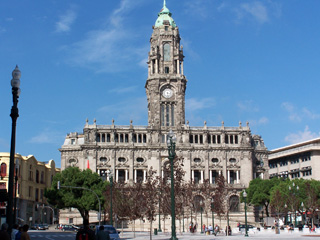
Avenida dos Aliados is the grand boulevard in the heart of Porto lined with attractive large buildings of diverse architectural styles. The Camara (City Hall) sits at the north end facing Praca Gen. Humberto Delgada. At the south is the Praca da Liberdade with the splendid Sao Bento Railway Station the main hall of which is covered with 20,000 tiles illustrating historical events painted by Jorge Colaco.
There were many events taking place in Porto and Lisboa in addition to tourist activity. Hotels were solidly booked when we started to make reservations. In Porto we stayed in two hotels and in Lisboa three.
The Hotel Internacional, Rua do Almada, 131 is a 5 minute stroll
from the Aliados Metro stop. Almada is a pretty street of
neat shops just west of and parallel to Avenida dos
Aliados, just take the tiny street next to the huge Bank
of Portugal and it's straight ahead. The building was a
convent and the public areas retain the traditional
historic charm with stone pillars, archways and beautiful
tile work on the walls. The breakfast room is very
pleasant with 1/2 blue/white tile walls, below the soft
mango paint, dark wood trim and relaxing art. The
breakfast buffet had all the basic offerings highlighted
by a sweet waitress who provided excellent service as did
the front desk staff. The rooms are in need of renovation
and upgrading in every respect. There is no internet
point for guests.
[Back
to Top]
The Hotel Dom Henrique, Rua Guedes De Azevado, 179 is a 5 minute walk from the Trinidade Metro stop which is just north of the City Hall in the center of the old city, a perfect location for tourists or business. This was Porto's first concrete high-rise building. It was originally built as an office building and the decision was made to turn it into the first 4 star hotel in the city. The exterior looks like the original intent, but walk in and find an inviting classic modern lobby and reception. The staff was friendly and helpful. Our sitting room and king bedroom were furnished with quality contemporary pieces. Lots of closet space and very good lighting were welcome. The good size bathroom was well stocked with basics needs including a hair dryer.
All the 122 rooms, including 22 suites and 16 non-smoking, are air conditioned. There is a business center with computer and printer/fax for complimentary guest use.
Breakfast is served in the attractive dining room adjacent to an atrium with a colorful mosaic wall. The breakfast buffet consists of fairly basic stuff.
After settling in at the Hotel Internacional we took a leisurely stroll south on Rua das Flores toward the Rio Douro. This pretty, narrow street was always home to many wholesale/retail and bargain stores, fine specialty shops and apartment buildings. We were delighted to see major renovation with the upgrading of present businesses and residences and the introduction of new ones. It's a street in transition, definitely for the better.
The wide Rua Mouzinho da Silveira runs parallel to Flores and is lined with old buildings and store fronts that have seen better days. It is the major thoroughfare from Praca da Liberdade to the river front. We were told that this is a priority street for renovation and rejuvenation. We hope it catches up to Rua das Flores.
Down at the Rio Douro the Praca da
Ribeira and Cais da Ribeira were packed with folks
soaking in the last rays of sunshine. Day and night this
is the hub of social life for tourists and locals. The
colorful ancient homes tumbling down to the remains of
the original town walls and the waterfront provide a
picturesque setting for the cafes, restaurants and shops.
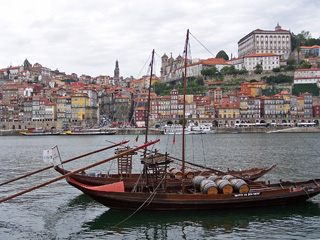
Walk across the lower level of the
stately Ponte D. Luis I, the bridge built in 1886,
designed by Theophile Seyrig, a former assistant to
Gustave Eiffel, and you are in Vila Nova de Gaia, home of
the Port Wine Lodges. Once again we were in awe of the
scene from where we had come. The panoramic view from
this side of the Douro is perhaps the most memorable we
have encountered in Portugal. Major renovation and
rejuvenation has taken place along the Gaia embankment.
Small gardens and pathways lead to and among new
contemporary buildings housing smart restaurants, cafes
and clubs. Anchored offshore adding color and culture to
the scene are the graceful "Barco Rabelos", the
ancient boats that transported the port from the Douro
Valley here to the lodges.
[Back
to Top]
Across the way there appeared to be many visitors to the Port Wine Lodges, which is quite normal. Many of the lodges and neighboring places to eat, drink and be merry along this side of the road have also been renovated and updated. Vila Nova de Gaia is now serious competition to the Ribeira across the way. Competition is GOOD.
It was time for dinner and a good sleep. Rua Bonjardim starts at Praca da Liberdade and runs north through the old city. It's a reflection of the history and culture of the city. The short curving block from Liberdade to Rua Passos Manuel is lined with large commercial buildings just begging to be restored. Proceeding north the street narrows and becomes home to ancient buildings with old shops and businesses that have been servicing the neighborhood forever. The smell of grilled chicken, sardines and fish is constant as is the scent of fresh baked bread. Speaking of frango no espeto (grilled chicken), there is no better place to enjoy it than Pedro Dos Frangos, Rua do Bonjardim 219/233. Be aware, there are two Pedros, across the street from one other. Pedro I was closed for renovations but II was open for business. We don't know what the renovations will bring but we found II to be the same inside as I had been. We were initially drawn in by the sight and smell of the nice size birds rotating on the spits just inside. The clincher was the line up of local gentlemen standing at the counter socializing while devouring the daily soup, frango, or one of the daily specials.
On this initial visit many years ago we were waiting for a spot to open at the counter when one of the staff standing at the rear waved to us to join him. Lo and behold he directed us upstairs to homey surroundings filled with happy, smiling folks. The chummy waiters directed us to a table, presented the menu and gave us time to get acquainted with our neighbors and make decisions.
Now that we were veterans we headed
directly to the rear and upstairs, but not before
stopping along the way to see what the experts were
eating this evening. Sardines and frango looked popular.
Portugal is sardines; I love sardines, roast sardinhas
smothered in grilled onions and green pepper with boiled
potatoes and salad for me. Linda is a fried fish person
so pescada filets with rice and salad for her. A very
good Vinho Verde was appreciated as was the corn bread.
This is neighborhood dining at friendly prices - it doesn't
get any better. Best of all, there are others like it in
the city - stay tuned. 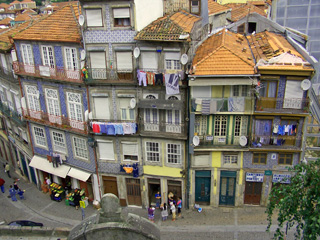
The Metro was connected to Gaia
with the conversion of the top level of the D. Luis I
bridge from vehicle traffic to rail lines and pedestrian
sidewalks that allow for super views of the city and the
river. We passed by the lower end of the famous shopping
boulevard, Rua Santa Catarina, to take a look at the old
book store, Latina, with the wooden book shelves stacked
with volumes climbing high up the walls. This is how a
house of books should look.
[Back
to Top]
Passing through Praca da Batalha it was good to see the Teatro Nacional de S. Joao being cleaned up and to learn that the interior had been renovated. The fortress-like Cathedral of Romanesque origins and Baroque renovation was also undergoing exterior renovation. It was inspiring to see the effort being made to preserve the heritage of the city. Nearby is the Ordem dos Arquitectos (institute of architects) where there is a display of stones and rocks going back to the 6th and 7th centuries B.C., the oldest ever found in the country. Architects come to Porto to study the local architecture which is based on simplicity and local materials.
Av. Vimara Peres leads to the top of the bridge. The day was sunny and clear, the air was crisp and fresh, the views were stimulating. At the Gaia end of the bridge is the lovely Jardim do Morro that would be a terrific spot for a picnic lunch. We are not big on picnic lunches so we followed the winding narrow streets of lovely homes down to the lower level of the bridge crossed to Porto and walked north to Praca Liberdade and continued on Rua Bandeira to Rua de Fernandes Tomas, turned left to Rua do Bolhao to number 95, Restaurante O Buraco, for lunch.
At the top end of this street is the Hotel Dom Henrique to which we would be moving in a few days. O Buraco had been recommended as having very good food at very good prices. It was true. We were warned that it is a very busy place and indeed it was. We were seated at the last open table on the ground floor. We were to later discover that there is a lower level. Dark woods and mirrors create a rather sophisticated feeling; the menu is traditional fare at very unsophisticated prices. Value plus.
We accepted the offered bolinhos (cylinders of ground salt cod, herbed, breaded and deep fried), a perfect rendition of this staple. Another favorable sign was the excellent grain bread and rolls. We started with sopa legumes and had breaded fried filets of cherne with arroz and salad as our main dish. It was melon time in Portugal and it is the best way to finish a meal. Our list of "real deal meals" continues to grow.
We were off to the new Casa da Musica, house of music, a fitting name. The architecture and location is controversial but to us it's a masterful execution of the vision and goal of its creators. It's a cultural treasure that will have a positive economic and social impact on the city.
In 2001 Porto was selected as one of two cultural capitals of Europe. The same year the Minister of Culture and the city founded Porto 2001, an organization committed to initiating cultural venues for the city. A concert hall was high on the list and five international architectural organizations were selected to participate in a restricted competition. OMA, Office of Metropolitan Architecture, a leading international partnership practicing contemporary architecture, urbanism and cultural analysis was chosen.
The location chosen is in the
historical center of the city, the Rotunda da Boavista.
Avenida Boavista is the major artery from the city center
to the western coast ending at Praca Goncalves Zarco.
Many of the roads in, out and around the city link to the
rotunda and there is a Metro stop minutes away as well as
frequent bus service. The rotunda and its historical park
is close to the old city center and a dividing spot
between the old and newer contemporary suburbs to the
west, the immediate surrounding area is in transition.
The strategy is for the Casa da Musica to be a catalyst
for renewal which will unite the old and new in a
positive fashion.
[Back
to Top]
We arrived by Metro, the Casa Da
Musica stop being the 3rd after Trinidade. 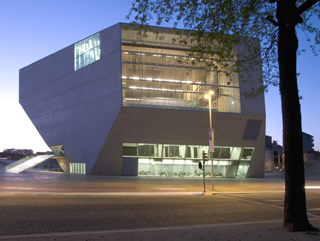 It is easy to see why the exterior design is
controversial. At first glance it's a massive block of
cement with windows. As we got closer and saw the design
of the angular lines of the facade, soft texture of the
cement blocks and the extensive window placement allowing
exposure of the interior (including a high and wide
section brilliantly using self-supporting corrugated
glass for maximum visibility), we became members of the
"I love it club". A clean cut, modern square,
with underground parking, has been built around the
perimeter and is linked to the green park across the way.
It is easy to see why the exterior design is
controversial. At first glance it's a massive block of
cement with windows. As we got closer and saw the design
of the angular lines of the facade, soft texture of the
cement blocks and the extensive window placement allowing
exposure of the interior (including a high and wide
section brilliantly using self-supporting corrugated
glass for maximum visibility), we became members of the
"I love it club". A clean cut, modern square,
with underground parking, has been built around the
perimeter and is linked to the green park across the way.
The goal of this House of Music is to have a balanced mix of shows featuring resident groups and visiting artists and to be a place of musical education and appreciation. To this end the expansive front staircase leads to a wide open entrance way to the lobby, no doors, welcome to Casa Da Musica. Music was with us all the way, softly in the background. The performer’s warm-up rooms are visible from the lobby enabling the public to observe and be involved before show time. If performers prefer, interior rooms with privacy are available.
The graceful angular design of the interior is stunning, featuring eye appealing textures of stone and cement with elements of brushed aluminum and glass.
The main concert hall seats 1238. The seats are comfortable with ample room between rows for easy passage. No need for vertical aisles taking valuable seating space. The acoustics are outstanding. The hall is hermetically sealed during performances. The walls and ceiling are made of pinewood with gold painted designs and the windows around are of curved glass. The second hall has 350 seats that can be removed to accommodate a standing audience of 700.
Children are the main target for music education. A Cyber Music Room for primary to secondary grade students is dedicated to teaching them how to create music using computers. The public can utilize the room when students are not there for a fee of 2E.
The Orange Room and Purple Room are for kids to have supervised fun while their parents are attending a show. They can look into the main hall through those curved windows, hear and see the performances.
There are bars and cafes on various levels and a quaint VIP room, decorated in traditional blue and white scenic tiles, in complete contrast to everything around it.
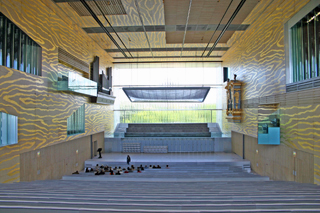 We bought tickets and returned a few
evenings later for a sold-out jazz concert in the main
hall. The program included Archie Shepp and Dar Gnawa de
Tanger. Archie on sax (and singing) and his group were
joined in the second set by Dar Gnawa and his group for a
unique integration of sound and culture. The group of
traditional jazz and black healer musicians of Morocco is
famous for their purification ceremonies using Gnawa
music and rhythms. The Portuguese are great music fans
and rewarded the performers with long rounds of applause.
We can attest to the marvelous acoustics and comfort of
the seats, it was a terrific evening. Casa Da Musica is
special; do plan to visit.
We bought tickets and returned a few
evenings later for a sold-out jazz concert in the main
hall. The program included Archie Shepp and Dar Gnawa de
Tanger. Archie on sax (and singing) and his group were
joined in the second set by Dar Gnawa and his group for a
unique integration of sound and culture. The group of
traditional jazz and black healer musicians of Morocco is
famous for their purification ceremonies using Gnawa
music and rhythms. The Portuguese are great music fans
and rewarded the performers with long rounds of applause.
We can attest to the marvelous acoustics and comfort of
the seats, it was a terrific evening. Casa Da Musica is
special; do plan to visit.
[Back
to Top]
Since Hotel Internacional does not have an internet point for guests we found our way to the internet cafe, On Web, Praca General Huberto Delgada, 291. It's in the basement, kept immaculately clean and very reasonably priced.
Tonight we returned to an old favorite, Restaurante Churrasqueira Moura, Rua do Almada, 219/233 the same street as our hotel just north of Praca de Filipa de Lencastre. Surprise, after all these years they put on a new front, painted and installed new furniture. It was always clean but now it was bright, fresh and clean and best of all the food and prices were the same. Rua do Almada like Rua do Bonjardim is an integral part of the old city and Moura is part of the neighborhood fiber.
We always start with soup - tonight, vegetable, pure heaven. What is soup without crusty, dense bread - not to fear, it was near. We opted for the daily special, grilled pork chops with sliced fried potatoes and salad. The house Santa Marta tinto was perfect. Good simple home cooking at unbelievably low prices.
We have explored the Douro Region quite extensively by car as you can read in our previous Portugal travelogues. Today we decided to hit the water and take a day train and boat cruise to Regua and back with Douro Azul the largest tour boat operator in Portugal. Besides daily cruises they operate hotel boats for various numbers of days, specialty boats in the style of those previously used for shipping port and mini yachts. They also have fine hotels along the way for those who would rather stay ashore, and helicopter tours over Porto and the Douro.
Our voyage began at the Sao Bento
train station at 09:15. As the incredible terraced
hillsides along the river came into view, fond memories
flooded back. Arriving in Regua at 11:15, we crossed the
street and boarded an electric train for the transfer to
the dock where our river boat awaited. Tables were set in
the lower level and the crew was ready to serve lunch as
soon as we departed. There was reserved seating at long
tables covered with white cloths and good quality table
settings. Lunch, which was very well presented and served,
consisted of traditional fare, vegetable soup, crusty
rolls, roast pork, potatoes, rice, lemon pudding and
coffee or tea. Red and white wine flowed freely. 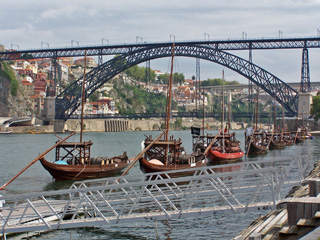
We enjoyed the perspective of the landscape from the middle of the river and were intrigued by the mechanics of going through the locks.
We arrived back at the Vila Nova de
Gaia dock at 17:30, walked across the bridge and got on
the funicular to Praca Batalha and headed over to check
email and then dinner at Churrasqueira Moura. Tonight it
was sopa caldo verde, fried fish filets for Linda and
grilled carapau for me. Of course lots of potatoes, salad,
and dense grain bread along with Santa Marta tinto and
melon to send us away smiling.
[Back
to Top]
Rua da Alfandega is a short street that runs from Rua do Infante D. Henrique to the waterfront. At number 10 is Casa Do Infante, so named for having been the birth place of Prince Henry the Navigator (in 1394), the famous Portuguese maritime explorer.
This stunning stone complex on the waterfront is the result of multiple renovations, expansions and various uses since 1325 when King Alfonso IV ordered the construction of a royal warehouse and the Customs House of Porto was born. The Mint and other services of the crown operated in adjacent buildings.
There were significant changes in the 17th century. The facade was brought closer to the street where it remains today. Two large roofs replaced the upper part of the towers. The medieval Mint building was destroyed and moved into the Customs House.
The Customs House moved to a building in Miragaia in the 19th century and the Casa do Infante became a merchandise warehouse for private companies. It was classified as a National Monument in 1924 and underwent a major renovation. At the end of the 1950s it was given to the city and the Office of City History was installed. In l980 the Oporto Historical Municipal Archives was established which office conserves municipal documentation dating back to the medieval period. This required an improvement and expansion of the facilities to make better use of the space and at the same time provided the opportunity to study the historical evolution of this architectural complex.
The old stone structure is handsome. Some of the restorations from the late 1950s were kept and enhanced. When a door or window was redone the difference between the old and new was displayed by distinguishing the type of stone finishes by means of an imperceptible separator. Modern design elements of wood, glass and steel have been added. This extraordinary effort to make the space more efficient and workable for today's tasks by blending the original structure into the updated version, all of which is user-friendly for persons with physical disabilities, was a major accomplishment.
The Museum is home to ancient architectural elements and structures that have been preserved and labeled. Roman mosaics were found in terrible condition. After creating wonderful reproductions they were cleaned and preserved for comparison with the copies.
The Museum also boasts a large interactive model of the city as it was in the Middle Ages. Push the button of a specific site and receive an audio response giving an excellent perspective of what it represented at that time. Collections of artifacts, pottery, tiles etc. from other countries illustrate how they influenced local design. Particularly intriguing are a group of original hand-painted tiles by Portuguese artists, and a series of drainage gutters made of hand painted tiles.
There is a room for cultural exhibits which at this time was featuring the history and traditions of Porto's sister city, Nagasaki, Japan. From costumes to crafts it was a bright, colorful, cheerful display.
The wood-beamed ceilings, stone
pillars, smart contemporary furnishings and computers of
the Archive Room with its river views offer the special
environment necessary for researching the archives.
Students use the computers to select the documents they
wish to see and the originals, which are stored nearby,
are quickly available for their inspection. We were happy
to finally see the inside of this building we had missed
on our previous visits to Porto.
[Back
to Top]
After that stimulating visit we
were ready for lunch. Restaurante Boa Nova on Muro Dos
Bacalhoeiros is just in front of the Casa do Infante, on
the shore of the river. The outdoor patio offers a river
scene but the day was cool so we chose to sit indoors.
Although in a tourist location, Boa Nova offers a very
good traditional menu at fair prices and thus is popular
with locals as well as visitors. We each had sopa de
horta (pureed potato, greens and rice) and shared grilled
cherne and vegetables. 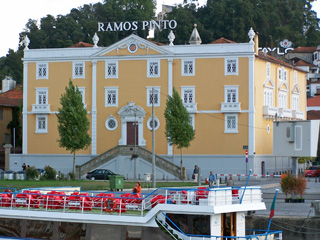
Ramos Pinto, one of Portugal's famous Port Houses , is located on the banks of Rio Douro at 380, Av. Ramos Pinto, Vila Nova de Gaia. The company was founded in 1880 by Adriano Ramos Pinto and later joined by his brother Antonio and other shareholders. The present location was acquired in 1907 was made up of a number of cellars, Port wine aging warehouses, and the head office administration. These buildings now house the main offices, visitors’ reception centre, shop and cultural department which includes the historical archives and Casa Ramos Pinto Museum.
Bold marketing has always been the hallmark of Ramos Pinto, so you will find the Ramos Pinto Palace the most striking building along the Port House strip. The Port business was very competitive and in order to establish a presence in the market the founders launched an innovative and bold "sexy" advertising campaign utilizing women to sell wine. Enter the Casa Ramos Pinto Museum and be treated to artists’ tile renditions of mythological scenes where Duriados, nymphs of the river Douro, pay homage to wine.
Adriano developed a "personal touch" by signing gift objects (wallets, letter openers, evening purses, etc.) and presenting them to ladies and gentlemen who truly appreciated his products. Adriano targeted Brazil as a major market and the "Adriano" label became synonymous with Port. He developed a marketing strategy which took advantage of well-publicized events to launch new products or promote existing ones.
The stunning museum rooms are filled with beautifully preserved antique office furnishings, a marvelous collection of old typewriters, printing machines and office artifacts much of which were utilized by the company and trace its history.
Of course no trip to a Port House
is complete without a stop in the reception center for
sampling the ruby, tawny and vintage Ports.
[Back
to Top]
Restaurante Lagostim, Praca D. Filipa de Lencastre, 200 had arrived on the scene since our last visit. Even from the outside it looked bright, cheerful and welcoming and indeed it was with an attractive long eating bar with stools and pretty blue and white dinner plates on display between the ancient stone walls. The real reason we went in was because the menu posted outside indicated they had cabrito assado tonight. A very good sign was that the sopa da legumes was superb. The roast goat was tender and tasty, the sliced fried potatoes were thin and crispy and the salad was fresh. The suggested vino tinto from Regua was a perfect marriage. It's a family affair and they really care. A splendid meal at very fair prices - a nice way to end the day.
The Museu Nacional de Soares dos Reis, Palacio dos Carrancas, Rua D. Manuel II is west of the city center. It was a 20 minute ride on bus #78 which we boarded on the west side of Avenida dos Aliados. We chatted with a man on the bus who told us which stop we should get off and followed it up by instructing the driver to tell us when we got there, which he did plus instructions on the direction to walk.
We found another treasure to add to
our Porto discoveries. The quality collections from a
variety of sources (religious, civic, public and private
institutions, private collectors and acquisitions) are
beautifully presented. Portuguese and foreign artists who
produced paintings and sculptures in Portugal from the 19th
century to the middle of the 20th are well represented.
There is sculpture and stonework from the Medieval period
to the 19th century. Particularly noteworthy was the
ceramics collection from 17th to the 20th century.
Rounding out the displays are Oriental porcelain,
Portuguese faience as well as gold works of civil and
religious pieces, jewelry, textiles, European and
Oriental furniture. All of these dating from the 17th to
19th century. 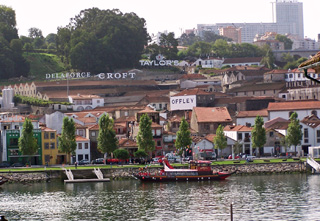
We took advantage of the snack bar
to have toasted sandwiches and coffee before boarding bus
#78 and continuing west to Praca de Congalves Zarco at
the coast, a lovely spot to breath the fresh ocean air.
We took bus #200 back into the center to Praca da
Liberdade. Each bus took a different route so we had the
opportunity to see a variety of areas between the center
and the coast, mostly attractive residential
neighborhoods with parks, gardens and room to roam.
[Back
to Top]
There is more to Vila Nova de Gaia than the Port Houses on the banks of the Douro. The upper part is a vibrant city and home to many of those who work in Porto. We got on the Metro D-Yellow line at Sao Bento and took it over the Ponte D. Luis I, where we had previously walked, to the end of the line, the Joao de Deus stop, at which there is a large enclosed shopping mall. The Metro runs along Avenida da Republica, a business and shopping avenue, where lots of folks were out and about. The Camara Municipal and Casa Municipal da Cultura were two impressive buildings on the avenue.
The east end of Rua de Passos Manuel is home to a local favorite, Restaurante Ribeiro. It's pure neighborhood ambiance including the half tiled walls and friendly waiters. It was difficult to choose from the tantalizing meat and fish offerings. We had yet to have arroz de marisco (rice and seafood) and it is a specialty here, so decision made. A bit of "cheese from the mountain" (fresh white cheese), and crusty rolls kept us busy until the pot of rice, shrimp, clams, calamari, and octopus arrived. It was an excellent rendition of this typical dish, rich in flavor of the sea with the right amount of heat.
We left the Hotel Dom Henrique
hoping to find birthday gifts for our daughters, Lisa and
Lori, nothing special in mind, just something special. We
headed south on the shopping street Rua de sa de Bandeira
and struck gold at #633. The window of Scoiattolo was
filled with some of the most creative handmade jewelry we
had seen in a long time and at very reasonable prices.
The two owners were as delightful as their creations. As
always it was panic time when faced with the awesome task
of making a buying decision - will they like it? The
ladies worked with us, what a team, our girls were
delighted. In between decision making time we shared
travel experiences and they suggested places to eat and
to visit in the area. Talented ladies, loaded with
personality and charm. Do pay them a visit. 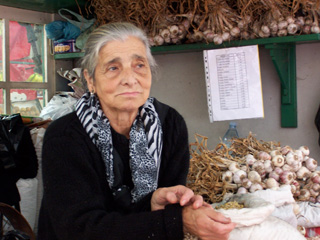
The Bolhao Mercado (market) was
just down the street and was hopping. The Scoiattolo
ladies had told us we must try iscas, a mixture salt cod
and herbs dipped in a batter of flour and eggs and deep
fried. Low and behold a sign in a tiny snack bar in the
Mercado featuring iscas! The small counter was filled,
but stools quickly became available and we placed our
order - they were right, good stuff. As usual it was fun
roaming the market and watching the vendors at work,
shouting, slicing, dicing, chopping, bagging, rearranging,
negotiating, counting money, chatting - all non-stop,
every minute productive.
[Back
to Top]
Between our iscas appetizer and the aromas surrounding our voyage through the aisles, we were soon contemplating serious eating, fortunately our new found Restaurante O Buraco, Rua do Bolhao, 95 was just around the corner. The first floor was already packed so we were seated in the comfortable lower level where we shared vegetable soup and a good sized grilled dourada with crisp skin and moist flesh accompanied by boiled potatoes and mixed salad. Superb, particularly at these very fair prices.
Rua de Santa Catarina is the shopping way in the old town. It's a pedestrian street lined with wonderful old and new shops. Many of the well-maintained historic buildings have awesome wrought iron balconies. At Massimo Dutti, in the modern, enclosed shopping mall, we found a few more winning gifts for our daughters. The hordes of people strolling up and down the street represent every demographic. It's a social event, not just a shopping trip. It's a people watching adventure.
We wandered down to Sao Bento train station to buy our tickets to Lisboa. The train will be leaving from the Campanha station east of the center which is 4 stops on the Metro from the Trinidade station. We returned to the hotel with time left for checking emails before getting ourselves organized for tomorrow's departure.
And time of course for our last
Porto meal at Pedro dos Frangos. Tonight it would be the
signature dish, frango no espeto with sliced fried
potatoes and salad, but first the daily sopa legume and
last fresh cut melon. The perfect way to remember Porto.
[Back
to Top]
Porto
| Cascais | Portel | Lisboa
São Miguel, Azores
Search TheTravelzine | TheTravelzine Group | Don's Gallery
Packing Hints | Planning
Tips | Cities
Links
All pages on TheTravelzine.com©Copyright 1996-2020 Don & Linda Freedman